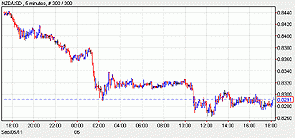
The New Zealand dollar dropped below 83 U.S. cents for the first time in almost two weeks as the Reserve Bank of Australia kept the benchmark rate on hold.
The kiwi dollar fell to 82.87 U.S. cents at 5pm from 83.14 cents at 8am, and was down from 84.03 cents in Northern Hemisphere trading.
Reserve Bank of Australia Governor Glenn Stevens kept the target cash rate on hold at 4.75%, saying the bank will continue to watch offshore volatility, and that medium-term inflation is becoming a concern.
Stevens said “the outlook for the global economy is less clear than it was earlier in the year.”
The release came after Australian government data showed a bigger current deficit than expected of A$7.42 billion, which further sapped investors’ appetite for higher-yielding, or riskier, assets after European stock markets sank amid heightened fears over a sovereign debt crisis.
“We’ll get all this offshore uncertainty, but the outlook is still pretty reasonable,” said Chris Tennent-Brown, FX economist at Commonwealth Bank of Australia in Sydney. “That’ll be the message from the RBA, and should be the message from the RBNZ next week.”
Tennent-Brown said the trans-Tasman currencies “are looking pretty resilient when you think about how much equities sold off in the U.K. and Europe last night.”
The kiwi fell 20 basis points immediately after the RBA announcement and was at 78.83 Australian cents at 5pm, down from 79.36 cents yesterday after the release.
The kiwi dollar dropped to 63.64 yen from 65.33 yen in yesterday and declined to 58.95 euro cents from 59.46 cents, and fell to 71.65 on the trade-weighted index from 72.48 yesterday. It fell to 51.52 pence from 52.11 pence last week.
(BusinessDesk)




We welcome your comments below. If you are not already registered, please register to comment.
Remember we welcome robust, respectful and insightful debate. We don't welcome abusive or defamatory comments and will de-register those repeatedly making such comments. Our current comment policy is here.